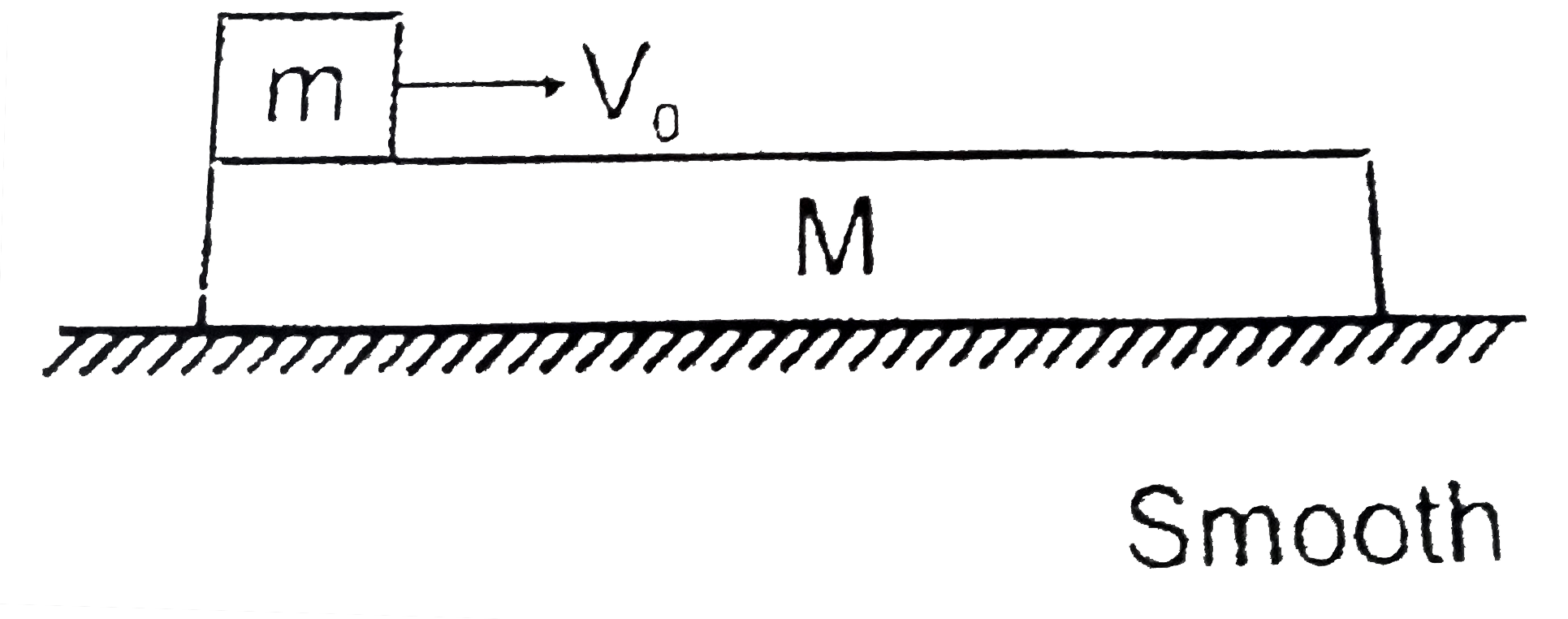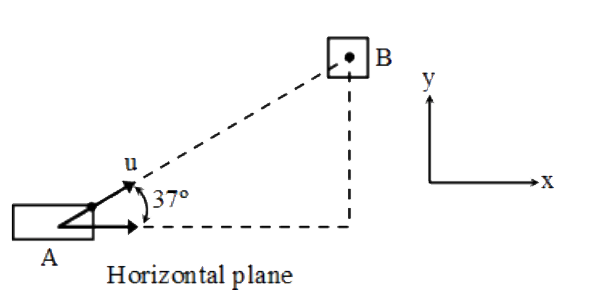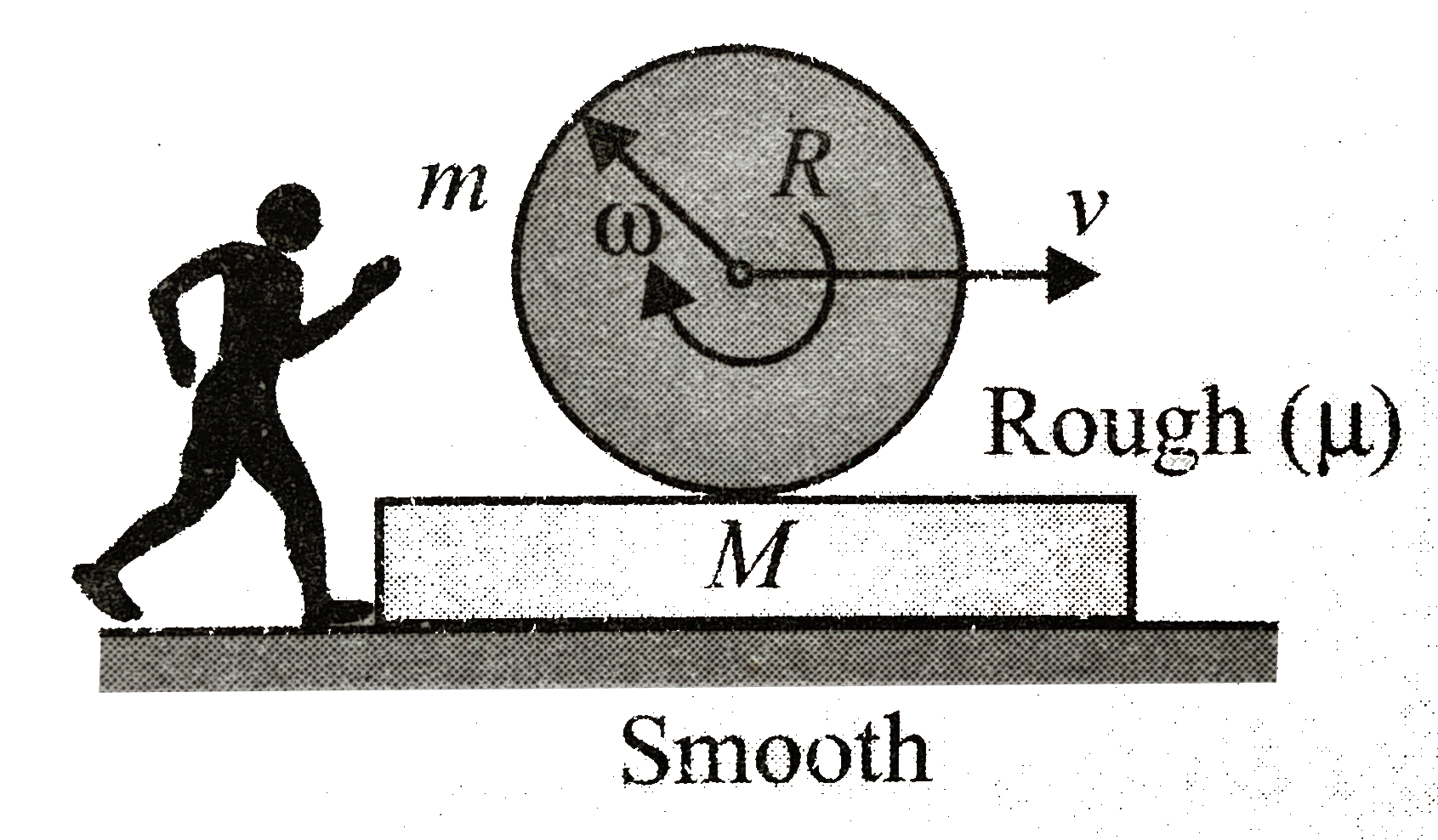A block is thrown with 14ms−1 over a long stationary plank as shown. Beofre the block comes at rest with respect to plank

Work done by kinetic friction on the block be -180J
Work done by kinetic friction on the block will be 140J
Net work done by kinetic friction on the block plank system will be -180J
Net work done by kinetic friction on the block plank system will be +140J
Vrel=Urel+arelt⇒t=2
Vblock=14−5×2=4
Vblock=0+2×2=4
Wblock=−12×2×(142−42)=−180J
Wblock=12×5×u2=40J
Wsystem=−140J
Topper's Solved these Questions
- BOOK - BANSALCHAPTER - TEST PAPERSEXERCISE - PHYSICS PART (A)32videos
TEST PAPERS
- BOOK - BANSALCHAPTER - TEST PAPERSEXERCISE - PHYSICS PART (B)3videos
TEST PAPERS
- BOOK - BANSALCHAPTER - TEST PAPERSEXERCISE - PHYSICS PART- C4videos
TEST PAPERS
- BOOK - BANSALCHAPTER - SEMICONDUCTORSEXERCISE - CBSE Question32videos
SEMICONDUCTORS
Similar Questions

The block of mass m is kept on plank of mass M. The block is given velocity V0 as shown. The coefficient of friction between the block of mass m and plank of mass M is μ and its value is such that block becomes stationary with respect to plank before it reaches the other end. Then:View SolutionA plank of mass M and length L is placed at rest on a smooth horizontal surface. A small block of mass m is projected with a velocity v0 from the left end of it as shown in figure. The coefficient of friction between the block and the plank is m, and its value is such that the block becomes stationary with respect to the plank before it reaches the other end.

a. Find the time and common velocity when relative sliding between the block and the plank stops.
b. Find the work done by the friction force on the block during the period it slides on the plank. Is the work positive or negative?
c. Calculate the work done on the plank during the same period. Is the work positive or negative?
d. Also, determine the net work done by friction, Is it positive or negative?View Solution
Knowledge Check
- Question 1 - Select One or More

The block of mass m is kept on plank of mass M. The block is given velocity V0 as shown. The coefficient of friction between the block of mass m and plank of mass M is μ and its value is such that block becomes stationary with respect to plank before it reaches the other end. Then:AThe work done b friction on the block is negativeBthe work done by friction on the plank is positiveCthe net work done by friction is negativeDnet work done by the friction is zero. - Question 2 - Select One
A block of mass M is tied to one end of a massless rope the other end of the rope is in the hands of a man of mass 2M as shown in the figure the block and the man are resting on a rough plank of mass M as shown in the figure the whole system is resting on a smooth horizontal surface the man pulls the rope pulley is massless and friction what is the displacement of the plank when the block meets the pulley ( Man does not leave his position on plank during the pull)
 A0.5mB1mCzeroD2/3m
A0.5mB1mCzeroD2/3m
A plank of mass M and length L is placed at rest on a smooth horizontal surface. A small block of mass m is projected with a velocity v0 from the left end of it as shown in figure. The coefficient of friction between the block and the plank is m, and its value is such that the block becomes stationary with respect to the plank before it reaches the other end.

a. Find the time and common velocity when relative sliding between the block and the plank stops.
b. Find the work done by the friction force on the block during the period it slides on the plank. Is the work positive or negative?
c. Calculate the work done on the plank during the same period. Is the work positive or negative?
d. Also, determine the net work done by friction, Is it positive or negative?View SolutionA man throws a ball of mass m from a moving plank (A). The ball has a horizontal component of velocity u=3√34ms−1 with respect to ground towards another man standing on stationary plank (B), as shown in the figure. The combined mass of plank A with man is 2m each. The x-y plane represents the horizontal plane which is frictionless. If initially, plank A was moving with speed uˆi with respect to ground, then the relative velocity of plank B (in m s−1) with respect to plank A (after the man on plank B catches the ball) minus 10ms−1 is
 View Solution
View SolutionA man throws a ball of mass m from a moving plank (A). The ball has a horizontal component of velocity u=3√34ms−1 with respect to ground towards another man standing on stationary plank (B), as shown in the figure. The combined mass of plank A with man is 2m each. The x-y plane represents the horizontal plane which is frictionless. If initially, plank A was moving with speed uˆi with respect to ground, then the relative velocity of plank B (in m s−1) with respect to plank A (after the man on plank B catches the ball) minus 10ms−1 is
 View Solution
View SolutionA plank of mass 10kg rests on a smooth horizontal surface. Two blocks A and B of masses mA=2kgandmB=1kg lies at a distance of 3m on the plank as shown in the distance of 3m on the plank as shown in the figure. The friction coefficient between the blocks and plank are μA=0.3andμB=0.1. Now a force F = 15 N is applied to the plank in horizontal direction. Find the time after which block A collides with B.
 View Solution
View SolutionA cylinder of mass at and radius R rolls on a stationary plank of mass M. The lower surface of the plank is smooth and the upper surface is sufficiently rough with a coefficient of friction μ. A man is to hold the plank stationary with respect to the ground, as shown Fig.

The force exerted by the man to keep the plank stationary is equal to……View SolutionA cylinder of mass at and radius R rolls on a stationary plank of mass M. The lower surface of the plank is smooth and the upper surface is sufficiently rough with a coefficient of friction μ. A man is to hold the plank stationary with respect to the ground, as shown Fig.

The force exerted by the man to keep the plank stationary is equal to……View Solution

